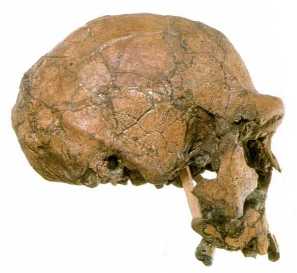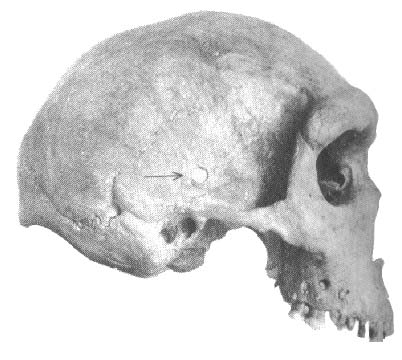|
Posted on 07/11/2002 4:13:07 PM PDT by jennyp
After a decade of digging through the sand dunes of northern Chad, Michel Brunet found a skull 6-7 million years old. He named it Toumaï.
Toumaï is thought to be the oldest fossil from a member of the human family. It's a dispatch from the time when humans and chimpanzee were going their separate evolutionary ways. A thrilling, but confusing dispatch1,2.
Sahelanthropus tchadensis - Toumaï's scientific name - was probably one of many similar species living in Africa at that time. "There must have been a group of apes knocking around between 5 and 8 million years ago for which there's a very poor fossil record," says anthropologist Bernard Wood of George Washington University in Washington DC.
Toumaï is the tip of that iceberg - one that could sink our current ideas about human evolution. "Anybody who thinks this isn't going to get more complex isn't learning from history," says Wood.
"When I went to medical school in 1963, human evolution looked like a ladder," he says. The ladder stepped from monkey to man through a progression of intermediates, each slightly less ape-like than the last.
Now human evolution looks like a bush. We have a menagerie of fossil hominids - the group containing everything thought more closely related to humans than chimps. How they are related to each other and which, if any of them, are human forebears is still debated.
Most members of the group are less than three million years old. After Toumaï, the next-oldest hominid is the 6-million-year old Orrorin tugenensis. But Orrorin is known only from a few teeth and bone scraps, and its evolutionary allegiances are controversial.
Our knowledge of Toumaï's period is "at the 1963 stage", says Wood.
Feature story
"When I first saw the skull I thought: 'Gee, it's a chimp'," says anthropologist Daniel Lieberman of Harvard University. Toumaï's brain, for example, was roughly chimp-sized. A closer look "blew my socks off", he recalls.
Sahelanthropus has many traits that shout 'hominid'. These include smaller canines, and thicker tooth enamel than apes. And the point at the back of skull where neck muscles attach suggests that Toumaï walked upright.
Many of Toumaï's advanced features are missing from later fossils such as Australopithecus, but reappear in still later species that are classified as Homo.
|
Based on this, we might have to question some species' place in the hominid club. If Australopithecus looks more ape-like than a much older fossil, how can it belong to the human family? "Anything with a more primitive face has to have its membership reviewed," says Wood.
No groups will be expelled on the evidence so far. The real lesson, says Wood, is that appearances are a bad guide to evolutionary relations. Hominid and ape species probably mixed and matched from a set of features, he says, with the same traits evolving independently on multiple lineages.
Toumaï has other features that are just strange. "It's got a massive brow ridge, the size of a large male gorilla, and yet it's just a little hominid," says Lieberman. This heavy brow leads many to believe that Toumaï was male.
Family feud
Where then does Toumaï fit on the family tree? He could belong on the chimp or hominid lines, or he could be part of a different branch of the family, more distant from both chimps and humans that either is from the other.
"I'm willing to bet some money that this is a hominid," says Lieberman.
Palaeoanthropologist Tim White of the University of California, Berkeley, agrees. He thinks that Toumaï might belong to Ardipithecus, a group defined by fossils dating from about 5.5-4.5 million years ago.
But Wood takes a different view. "My guess is that it's neither a chimp nor a human ancestor - it's a creature that was living at the same time."
To solve the mystery we need more fossils from the same period. Unfortunately our relatives' habits may be against us. The forests favoured by chimps, and apparently by early hominids, are not conducive to fossil formation. Chimps, for example, have no fossil record.
On the bright side, Toumaï's discovery suggests that, even if they were rarely fossilized, ancient apes and hominids roamed right across Africa. "Finding hominids in the Sahara was a bit of a long shot," says Wood. So far, most fossil hominids have turned up in the east, with a few further south.
But desert-bound palaeontologists be warned: "There are brutal field conditions," says Lieberman.



But look what we've accomplished! First-rate science takes great imagination and great courage. Scientists shouldn't be denigrated because an ignorant public demands certainty when there is none.
The point I am trying to make is that evolutionist theory is still trying to fight creationists and in doing so may be holding on to some very false premises. The Earth ain't 8000 years old. But I also think evolution theory as it is now can't be supported even by the weight of it's own evidence. The theories get more convoluted every day. But then again- I am just an amateur science page reader.


The point is, the transitions at this point look very gradual to me, as along a continuum.

TONIGHT (6pm pdt/9pm edt) on UNSPUN!
ANN COULTER and JESSE LEE PETERSON!
Click HERE and Listen LIVE while you FREEP!
ALSO! RadioFR's new CHAT SERVER IS UP! Come on in and CHAT!
Yup, until the next pseudo-man is dug up
< / sarcasm >
I was trying to say this is really hard stuff. A scientist looks at the new skull and tries to fit it into his existing theories. If he can't he's got to come up with new ones. The only alternative is to throw out the evidence and keep the theories. That's a real loser .
huh, odd
Personally, I think evolutionists have gotten away with unwarranted speculation for far too long. The fossil record either shows a continuous development of life from the presently extant organisms to the extinct ones of the past, or it doesn't.
If it doesn't they should just deal with it.
Simply explaining away the absence of fossil evidence in the form of transitionals or conjuring up stories to fill in the gaps is not science.
Brian.
But if evolution is thrown out because it can't explain new evidence I very much doubt we'll return to theories that couldn't even explain the old evidence. A good theory will have to explain all the current evidence and stand up, at least for awhile, to new discoveries.
Funny, that doesn't look like Strom.
Throw in a Neanderthal skull and you'll really show how tough it is to cram these fossils into a linear chain. I suspect that hundred years from now the bush of hominid evolution will appear much more overgrown than we'd ever believe now.
If you doubt this, consider the fact that all of the useful and practical knowledge derived from the theory [anti-microbial resistance, pesticide resistance etc] can be summarized as micro-evolution.
Micro evolution can be [and is] assimilated by either creationism or ID, so if all of the science establishment were to suddenly become born again Christians and begin to promote a young-earth world view, the sky would not fall, as medicine, biology, genetics etc., would proceed on as nothing ever happened.
Brian.
Disclaimer: Opinions posted on Free Republic are those of the individual posters and do not necessarily represent the opinion of Free Republic or its management. All materials posted herein are protected by copyright law and the exemption for fair use of copyrighted works.